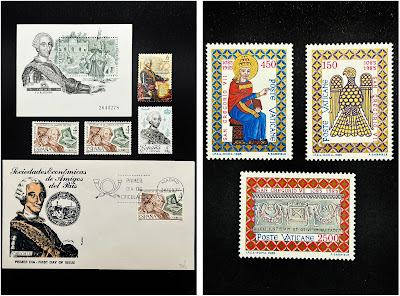Gianandrea de Antonellis’ treatise, “Un caso concreto: il Carlismo nel Regno di Napoli” (A Concrete Case: Carlism in the Kingdom of Naples), published on altaterradilavoro.com on May 21, 2025, offers a deeply reflective exploration of Carlism in relation to the cultural and historical identity of the Kingdom of Naples. Drawing from his previously published monograph, Carlismo per Napolitani (Edizioni Solfanelli, 2022), the author seeks to reintroduce the core principles of Carlism—a Spanish traditionalist, monarchist, and Catholic political doctrine—within a Neapolitan context. The essay is structured around the Carlist quadrilemma: Dio, Patria, Fueros, Re legittimo (God, Homeland, Traditional Rights, Legitimate King), and utilizes this framework to argue for the compatibility of Carlism with the culture and traditions of the Neapolitan people.Adopting a firmly traditionalist and counter-revolutionary tone, the article aims to restore a political vision rooted in religion, local identity, and monarchy—depicted as organic and community-oriented—contrasting sharply with what the author terms "ideologies" (such as Jacobinism, socialism, liberalism, etc.), which are criticized as artificial, abstract, and imposed by bureaucratic powers from above.The fourfold Carlist principle provides the article’s structure:1. God: The author asserts the primacy of Catholicism not only as a religion but also as a foundation for political life. He rejects religious pluralism, stating, “as this would imply acceptance of something that does not represent the Truth.”
“There is only one Truth, and we believe it is the one always taught by the Catholic Church. Accepting deviations from the Truth ends up equating Truth with falsehood—and worse, often subordinating the Truth in the name of 'Liberty' to fleeting whims. This is seen both in religion and in morality (which are tightly connected).
“Therefore, Catholicism must be the fundamental reference point for politics, and religion should not be subordinated to politics; rather, the reverse. This does not mean subordinating the state to the Church, but rather to religion, natural law, and natural morality derived from Catholic teaching.
“Historically, the Kingdom of Naples has always been Catholic. Even during the dramatic era of Protestant heresies and religious wars, it remained largely untouched. Naples showed no substantial interest in Protestantism, which only passed through the Kingdom via a few figures sympathetic to Protestant or heretical ideas (notably Tommaso Campanella and Giordano Bruno). But these were isolated cases, and their time in Naples was brief and had no real impact on the widespread faith of the Neapolitan people.”
De Antonellis portrays Catholicism as historically essential to Neapolitan identity, using the Masaniello revolt as an example of popular support for both religion and monarchy.
“Thus, Catholicism has always triumphed in Neapolitan hearts. A striking example is Masaniello, the famed popular leader who briefly took power for about ten days in the summer of 1647 following a popular revolt. This revolt was not anti-Spanish, nor could it be called a revolution, since it erupted with the cry: ‘Long live the King of Spain, death to bad governance.’
“A side note: the revolt arose not from opposition to paying a donation to the King of Naples (also King of Castile, León, etc.) to finance the war against heretics in Flanders, but from opposition to the method of taxation—specifically, a fruit tax that disproportionately affected the poorest. At the time, Neapolitans were called leaf-eaters (not macaroni-eaters, a label that came later), as meat and pasta were reserved for the upper classes while common folk lived on fruits and vegetables. A tax on fruit thus sparked resentment among the lower classes.
“It’s worth noting that Masaniello himself affirmed the need for the donation to finance the war in Flanders, as the Neapolitan people supported the war against heretics. He merely asked that it be funded through a different tax, preferably on land rather than fruit.
“This example illustrates the alignment between Neapolitan popular faith and the idea that the state must be subordinate to the Catholic religion, rejecting and preferably not even tolerating other religions.”
2. Homeland: Here, “patria” is interpreted in a local, naturalistic sense. The homeland is not the modern nation-state, but the local soil—village, city, or region.
“The second point is the Homeland. This concept must be understood in the natural sense: homeland as motherland, the land where one is born, lives, and dies. Until the last century, the common aspiration was to remain in the same place. The lucky person was the one who could be born, live, and die in the same village, growing attached to it.
“Though modern society has changed this dynamic, the idea remains: attachment to the homeland—the place whose air we breathed from birth—creates a special love. This love starts with the village (or neighborhood, in cities) and gradually extends outward, much like love for one’s family begins with parents and siblings, then includes grandparents, cousins, and beyond.
“In patriotic terms, we love our village, then our town, and finally, using old terms, the County and Kingdom—or in modern terms, the province, the region, and finally the State. But love for the greater entity is subordinate to the love we feel for our specific, concrete homeland.”
De Antonellis critiques nationalism as artificial and aggressive, whereas love for the homeland is presented as peaceful, fraternal, and traditional.
“Importantly, love for one’s homeland does not compete with the patriotism of others. Nationalism, on the other hand, does create rivalry—French vs. Germans, Northern Italians vs. Neapolitans, etc. True patriotism is different: one who loves their homeland sees a kindred spirit in someone who loves theirs, just like someone who deeply loves their own mother respects others who love theirs.”
3. Fueros: In one of the strongest sections, the author explains the concept of fueros (traditional, local rights) as antithetical to the centralizing ideologies of modern states.
“Fueros originally referred to local acquired rights—famously the fueros of the Basque regions, but also those of each kingdom and locality. These are concrete rights, like those claimed by Masaniello and his compatriots, not to be taxed without the consent of the people’s council.
“These are concrete liberties (strictly in the plural), as opposed to the abstract ‘liberty’ (in the singular) promoted by the French Revolution. They were recognized by the Crown and each King, upon coronation, swore to uphold them—either directly or via a representative (e.g., the Viceroy in Naples). This occurred in Naples, Sicily, Sardinia, Aragon, Castile, León, etc.
“In some cases, local representatives explicitly stated: ‘You swore to uphold our rights, and we swear to respect you only so long as you defend them. Otherwise, though we are lesser than you individually, together we are more, and we will not respect you.’
“This conditional loyalty reflects a system where the monarch is not sovereign or absolute, as he is bound by duties, downward to the people via local rights, and upward to divine law via natural law.”
This leads to a critique of modern legal positivism, which, as de Antonellis makes clear, enables abuses such as abortion, euthanasia, and state tyranny. The Carlist preference for natural law and local autonomy is presented as a just alternative.
“Paradoxically, it is only after the French Revolution that true absolutism arises, where an authority (now the modern State) can disregard both local rights and natural law, creating laws based solely on majority will. This leads to perversions like abortion being declared an 'inalienable' right in France’s constitution or historical persecutions justified by law, including the recent marginalization of the unvaccinated or the Nazi persecution of Jews.
“Such positivist legal systems can deem anything legal, even the forced euthanasia of disabled persons or the unborn. This is utterly rejected by Carlist thought, which upholds natural law as a cornerstone of political doctrine.”
4. Legitimate King: The final section distinguishes between the legitimacy of origin (hereditary succession) and legitimacy of exercise (a monarch’s moral and political performance).
“Legitimacy has two aspects: origin and exercise. The first determines who is King. Carlism (and only Carlism), rooted in traditional Spanish political thought, explicitly introduced the legitimacy of exercise as well. That is, a rightful king must also prove to be a good king—upholding religion, homeland, and traditional rights.”
De Antonellis uses this distinction to defend historical Carlist decisions to depose monarchs.
“If not, he loses legitimacy. Carlism enforced this principle twice: replacing Juan III in the 1800s with Carlos VII, and Carlos Hugo in the 1900s with Don Sixtus Henry, or Enrique V (Enrique I for Neapolitans).”
The author then traces a Neapolitan intellectual tradition, analogous to the Spanish, that preceded this principle.
“A ‘Neapolitan traditionalist’ school of thought, parallel to the Spanish one, existed and shared this principle. Thinkers like Giovanni Lanario (16th century), his nephew Francesco Lanario (17th century), who wrote The Warlike Prince (a Neapolitan response to Machiavelli), Ottavio Sammarco, and Giambattista Vico expressed similar ideas. In the late 18th century, Nicola Spedalieri influenced Antonio Capece Minutolo, Prince of Canosa—a 'proto-Carlist' who died in 1838 during the First Carlist War, already aligned with King Carlos’s cause.
“Though there wasn’t a continuous ‘school’ in the formal sense, there was a line of thought—a tradition rediscovered in the 20th century by lawyer Silvio Vitale and continued today by scholars who, though they never met Canosa or his predecessors, carry on their intellectual heritage.
“There is a Neapolitan traditionalism perfectly compatible—and in some cases even anticipating—Spanish Carlist thought.”
The article paints Spanish rule over Naples not as foreign domination, but as a golden age of cultural and political vitality, refuting the nationalistic post-Unification view that frames the Spanish presence as oppressive.
“The King of Naples considered himself Neapolitan—just as he was Castilian for Castile, Leonese for León, Aragonese for Aragon, etc.
“We should view the Spanish era politically as we do its art history—as our own ‘Golden Age.’ That golden age in the arts presupposes a mindset—Hispanic, yes—but open and creative, not obscurantist.”
De Antonellis sees Naples as spiritually and politically aligned with Spain and positions Hispanism for Neapolitans as a prerequisite to accepting Carlism.
“Hispanism is not just a bond between Spain and Hispanic America (Mexico to Argentina and Chile), but also includes parts of the Italian peninsula once part of ‘the Spains,’ under the Catholic King—particularly the Kingdom of Naples, but also Sicily, Sardinia, the Duchy of Milan, and the State of the Presidi.
“Naples, as Francisco Elías de Tejada put it, was ‘the most radiant pearl in the crown of the King of Spain,’ a leading cultural and historical center from the early 1500s to late 1600s—more so than Madrid at the time. Naples was the foremost city of the Spains, even if the King resided in Iberia.”
In its final reflections, the essay portrays tradition as a living inheritance meant to be carried forward, while lamenting the decline of historical memory and condemning both revolutionary erasure and conservative stagnation.
“Let me end with a definition of tradition: ‘Tradition is not the worship of ashes but the preservation of fire.’ It means not preserving things as they are (that’s conservatism, a false tradition), but improving what we inherit to pass it on to future generations (tradere).
“That is true traditionalism—standing between the revolutionary desire to erase everything and the conservative desire to preserve even distortions.”
Un caso concreto: il Carlismo nel Regno di Napoli is a compelling example of traditionalist political thought applied to regional identity and historical memory. It functions effectively as a political-theological meditation and a call to cultural reawakening. For readers interested in Carlism, counter-revolutionary thought, or alternative readings of southern Italian history, this essay offers a rich and provocative perspective—one that is both intellectually rigorous and unapologetically polemical in its execution.
~ By Giovanni di Napoli, May 29th, The Ascension of Our Lord Jesus Christ
* Translations are my own






































